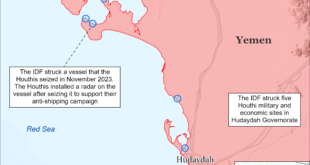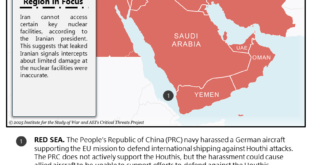Under a Russian-sponsored agreement, the Syrian government-affiliated National Defense Forces retreated from the Tayy neighborhood in Qamishli, which is now under the control of the Kurdish-led Autonomous Administration.
The Tayy neighborhood in the city of Qamishli, in the countryside of Hasakah province in northeast Syria, is witnessing a gradual return of basic services. There have been ongoing efforts to secure protection for residents who have returned to their homes since the neighborhood is now under the control of the Autonomous Administration of North and East Syria, affiliated with the Kurdish-led Syrian Democratic Forces (SDF).
The Autonomous Administration took control of the Tayy neighborhood after it managed to drive out the Syrian government-affiliated National Defense Forces. This came close on the heels of a permanent truce agreement that was reached under Russian mediation on April 25. The agreement ended the fighting between the Autonomous Administration’s internal security forces known as Asayish and the National Defense Forces that broke out in the neighborhood on April 20, pushing the residents to flee toward safer neighborhoods.
As part of the truce agreement, the Russian military police, which sponsored the agreement between the two sides, will conduct joint patrols with the Asayish forces inside the neighborhood.
On April 27, the deputy head of the Russian Defense Ministry’s Center for Reconciliation at the Khmeimem base, Alexander Karpov, announced the deployment of Russian patrols in the city of Qamishli, with the aim of ensuring an end to the clashes between the two sides. Russia Today news agency quoted Karpov as saying, “After the clashes between Arab and Kurdish residents, the Russian military police are patrolling the neighborhoods in Qamishli, covered by Russian helicopters, in order to prevent any provocations.”
He added, “The efforts of the Reconciliation Center led to the cessation of the clashes in Qamishli and the stability of the situation there.”
It appears that the agreement that followed the fighting between the Syrian government and the Autonomous Administration has changed the map of control in Qamishli, seemingly in favor of the Autonomous Administration that emerged victorious from the clashes.
On April 25, the Syrian North-Press website, which is close to the Autonomous Administration, cited a negotiating source who spoke on the agreement terms as saying, “The Asayish will remain in the points they controlled within the Tayy neighborhood, while the National Defense Forces loyal to the Damascus government will depart and be located away from the confrontation lines with the Asayish. People will also return to their homes with the Russian military police and Asayish jointly patrolling the neighborhood.”
An official in the Autonomous Administration in Qamishli told Al-Monitor on condition of anonymity, “National Defense Forces operatives tried to thwart and have tried to violate the agreement more than once just hours after signing it. Our Asayish forces, however, managed to drive them completely out of the neighborhood and forced them to abide by the agreement.”
He noted, “The National Defense Forces have completely withdrawn from the Tayy neighborhood, with the exception of the Abbas Allawi School, which has become a security site for the Syrian regime. The Syrian forces are also deployed in the streets in the vicinity of the water tower in the neighborhood.”
He noted, “These points constitute a security zone for the Syrian government security institutions, stretching from the southern side of Qamishli city near the Tayy neighborhood roundabout and the Zunoud neighborhood. The Syrian regime’s presence in the neighborhood is symbolic [although] it extends over a small area, while the entire city’s neighborhoods are under the control of the Autonomous Administration and its service institutions.”
The source added, “According to the new distribution of control, the Asayish were able to fully open the southern road after the liberation of the Tayy neighborhood. The southern road was closed due to the deployment of the National Defense Forces checkpoints there. The Asayish also removed the barriers and cement blocks that had been put up by the National Defense Forces along the southern road, which is now open for the area’s residents.”
The Tayy neighborhood is located on the southern side of the city of Qamishli and is bordered to the south side by al-Wusta and the Assyrian neighborhoods and to the northeastern side by the Seryan neighborhood.
The Masaken neighborhood lies to the east of Tayy, and is separated from the Tayy neighborhood by the Jaghjagh River. The neighborhoods of Corniche, Halko and al-Zuhour border the Tayy neighborhood all the way to the southern city belt.
Although the area is under the control of the SDF, the Tayy neighborhood had been a prominent stronghold of the regime’s National Defense Forces. It is also home to several Arab tribe members of Tayy, who are loyal to the Syrian government. The tribe has mobilized many of its members to join the National Defense Forces’ ranks.
The official at the Autonomous Administration said, “After withdrawing from the Tayy neighborhood, the National Defense Forces headed toward the villages extending toward the south and southeast of the neighborhood, all the way to the M4 international highway and the Khirbet Amo checkpoint in the southeastern countryside of Qamishli.”
He added, “The National Defense Forces and the regime forces are mostly deployed in these areas, but most importantly inside the Qamishli airport and the 154th Regiment. These two military bases are connected to the National Defense Forces’ station in the countryside of Qamishli.”
Mohammad Baqai, a researcher at the NMA Center for Contemporary Research who resides in the countryside of Aleppo, told Al-Monitor, “What happened in Qamishli was that the National Defense Forces retreated from the Tayy neighborhood, keeping only symbolic security points for the regime inside the neighborhood.”
He said, “But as we have seen, the National Defense Forces are still present on the outskirts of Qamishli from the southern side at the airport and inside the villages where the members of the loyalist Tayy tribe are present. This raises the fears of the Autonomous Administration as to the National Defense Forces attempts to return to the city.”
Baqai concluded, “The Autonomous Administration does not trust the Russian side that sponsored the agreement. This means that Qamishli might witness the outbreak of new clashes in the coming weeks, as long as the Syrian regime maintains a significant military presence in the countryside of Qamishli.”
 Eurasia Press & News
Eurasia Press & News


